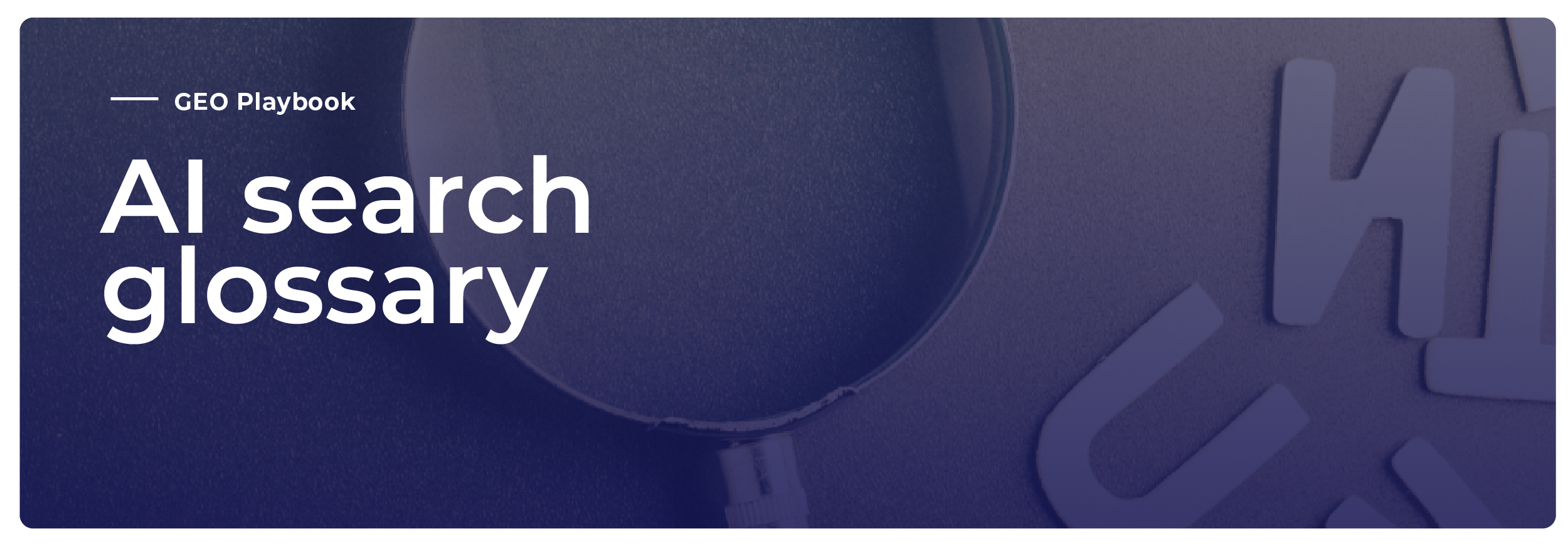_____ THE GEO PLAYBOOK
Glossary of AI and GEO terms

Generative search comes with its own language. This glossary breaks down the most common terms you’ll encounter when planning or reading about Generative Engine Optimisation (GEO) - from AI fundamentals to technical SEO concepts.
Each definition is short, practical, and free of jargon.
A
Artificial intelligence (AI)
The field of computer science that enables machines to simulate human intelligence - learning, reasoning, and generating content or predictions.
AiPR (AI Public Relations)
A PR approach designed for the AI era. It focuses on earning coverage and mentions that consistently describe a brand in the same way, teaching AI models to associate that brand with a specific area of expertise.
AI Overviews (Google SGE)
Google’s experimental generative search feature that uses AI to summarise results and provide direct answers at the top of the page. It’s sometimes called Search Generative Experience (SGE).
AI visibility
The presence and frequency of a brand being mentioned or cited within AI-generated answers across tools like ChatGPT, Gemini, and Perplexity.
 Track your brand’s citations using our AI visibility tracker.
Track your brand’s citations using our AI visibility tracker.
Algorithm
A set of rules that determines how search engines or AI systems process, rank, and present information.
B
Brand descriptor
A short, repeatable phrase (e.g. “UK insurance specialists”) used consistently across web pages and PR coverage to strengthen a brand’s association with a topic.
Browse mode (ChatGPT)
An optional setting that allows ChatGPT to access live web data instead of relying solely on its training information.
Bing Chat (Microsoft Copilot)
Microsoft’s AI chat integrated into Bing search and Edge browser, also called Copilot. It uses OpenAI’s GPT-4 model to answer questions and can retrieve live web data. It often cites sources with hyperlinks, merging traditional search with AI.
C
Canonical tag
An HTML element that signals to search engines which version of a page is the original or preferred source, preventing duplicate content issues.
ChatGPT
An AI chatbot developed by OpenAI that uses large language models (LLMs) to generate human-like text responses. It can answer questions, write content, and, in browse mode, access live web data.
Citation
A mention of a brand, page, or source within an AI-generated answer. Citations can include a clickable link or text-only reference, depending on the platform.
Citation share
The percentage of total AI responses that reference your brand compared to competitors.
Claude
An AI assistant created by Anthropic, designed to analyse long documents and provide detailed, safe, and transparent answers. Known for its strong reasoning ability and careful handling of factual accuracy.
Context wrapping
The process of pairing a brand name with consistent language in PR coverage and content so that AI systems link the brand to its area of expertise.
 Read our guide to context wrapping.
Read our guide to context wrapping.
Crawlability
How easily search or AI crawlers can access and interpret a website’s content.
D
Data freshness
The recency and accuracy of the information published on a site - a key signal for AI systems deciding which sources to reference.
Digital PR
A strategy that combines traditional PR tactics with SEO objectives, earning high-quality backlinks and mentions to improve authority and visibility.
E
Entity
A distinct, recognisable concept such as a brand, person, or topic that search engines and AI use to categorise information.
Entity coverage
How completely a website covers the related sub-topics, entities, or fan-outs around a subject. High entity coverage helps AI understand expertise and context.
E-E-A-T
An acronym for Experience, Expertise, Authoritativeness, and Trustworthiness - Google’s key framework for assessing content quality.
F
Fan-outs
Related sub-questions that branch from a main query and reflect how people and AI explore a topic. Covering key fan-outs builds topical depth and makes your content more quotable.
Fan-out mapping
A structured process to find and prioritise sub-questions across AI tools and search data, then turn them into page updates or briefs. The output is a mapped list of gaps and recommended formats.
FOI (Freedom of Information)
A request submitted to public bodies to obtain official data that can be used to generate unique research or PR stories.
 Learn more about Freedom of Information requests.
Learn more about Freedom of Information requests.
G
Gemini (Google)
Google’s large language model (LLM) and the foundation for AI Overviews. Gemini integrates with Google Search to deliver conversational results and summarised answers.
Generative AI
A type of AI that creates new content (text, images, or code) using information it has learned from existing data.
Generative Engine Optimisation (GEO)
Strategies and tactics to improve a brand’s visibility in AI-generated search results and answers, ensuring that chatbots and AI search tools reference, cite, or recommend your content when relevant questions are asked.
Generative search
A search experience powered by AI that delivers complete, conversational answers instead of a list of links. Google’s AI Overviews are one example of generative search in action.
GEO agency
A digital marketing agency that helps brands earn visibility inside AI-generated answers. A GEO agency blends SEO, Digital PR, and data science to optimise how content is structured, cited, and reused by AI systems.
GEO audit
An in-depth review of how visible a brand is in AI search. It benchmarks technical, on-site and off-site factors that affect AI visibility and provides clear recommendations to improve them.
H
Hyper Relevancy Projects (HRP)
Data-led, evergreen content assets designed to attract organic links and build topical authority. These pages continue earning citations and backlinks over time.
HTML markup
The code that structures web content and signals key information to search and AI crawlers.
I
Indexing
The process of adding web pages to a search engine or an AI model’s database so they can appear in results.
Internal linking
Links that connect one page on your website to another, helping search engines and AI understand topic relationships.
L
Large Language Model (LLM)
An AI system trained on vast text datasets to understand and generate human-like language. LLMs power tools like ChatGPT, Gemini, and Claude.
 Download your LLM optimisation checklist
Download your LLM optimisation checklist
Link equity
The authority passed between web pages through internal and external links, influencing how search engines and AI evaluate importance.
Local GEO
The practice of applying GEO tactics to improve AI visibility for location-based searches and regional prompts.
M
Metadata
Information that describes a web page (title, description, keywords) and helps search and AI systems understand its purpose
Machine learning
A subset of AI where algorithms improve their performance over time based on data patterns.
O
Off-site GEO
The process of earning credible external mentions that AI can recognise and cite, through Digital PR, AiPR and context wrapping.
On-site GEO
The process of structuring and writing content so that AI models can extract accurate, liftable information - such as definitions, tables, and FAQs.
Organic visibility
How often a site appears in unpaid (non-advertising) search or AI-generated results.
P
Perplexity AI
An AI-powered search tool that combines chatbot functionality with web citations. It’s known for its clear source attribution and concise answer formatting.
Prompt
A question or instruction given to an AI system. Optimising content around natural-language prompts helps your brand appear in relevant answers.
Prompt testing
Running specific natural-language questions across multiple AI tools to see how, or if, your brand appears in generated answers.
R
Ranking
The order in which search engines display results for a given query. GEO focuses instead on being referenced within AI answers.
Reinforcement
In GEO, the repeated use of consistent language and context that strengthens brand-topic associations within AI models.
S
Schema markup
Code added to a web page that provides structured information (like reviews, FAQs, or prices) to search engines and AI.
Schema validation
The process of checking structured data for errors to ensure search engines and AI systems can correctly interpret it.
Search Generative Experience (SGE)
Google’s experimental AI integration in search results. SGE uses generative AI to answer queries directly on the results page with a conversational response, often pulling information from multiple sites and citing them. It’s Google’s way of blending traditional search with AI answers.
Search intent
The goal behind a user’s query - whether they want information, a comparison, or to make a purchase.
T
Technical GEO
The process of improving your website’s technical setup (such as crawlability, structured data, and speed), so AI platforms can access and understand your content.
Topic clustering
Organising your content into related groups that link back to a central ‘pillar’ page, helping both AI and search engines interpret expertise.
Topical relevance
A measure of how well your content addresses all key aspects of a subject. Strong topical relevance signals expertise to both search engines and AI tools.
Transformer
The neural network architecture underlying most modern LLMs (like GPT). Transformers enable models to pay “attention” to different parts of text, allowing for understanding context and meaning in sentences. It’s worth noting conceptually because it’s why LLMs are so good at language - they learn relationships between words and concepts, which is why context (in context wrapping, for instance) is so important.
U
User intent
The underlying motivation behind a search or prompt - what the user truly wants to find or learn.
URL structure
The way your web addresses are organised. Simple, logical URLs help both users and AI understand your site.
V
Visibility
How often a brand appears or is cited across AI-generated results, search rankings, and external publications.
Voice search
Queries made verbally using assistants like Siri or Alexa. As LLMs evolve, voice and generative search increasingly overlap.
W
Web crawling
The automated process where search or AI bots explore web pages to collect information for indexing or training.
Workflow automation
Using AI tools or scripts to streamline repetitive tasks such as content audits, prompt testing, or citation tracking.
How AI-ready is your brand?
Here is everything you need to get started with GEO. Use these resources to check the essentials, build a plan, and benchmark your AI visibility.
 Download the LLM optimisation checklist
Download the LLM optimisation checklist
Review on-site, off-site and technical readiness. It highlights crawler access, schema, data freshness and trust signals so you can spot quick fixes.
 Get the 90-day GEO roadmap to AI visibility
Get the 90-day GEO roadmap to AI visibility
Follow a phased plan that turns foundations into delivery across technical, on-site and off-site work - like AiPR - with simple milestones your team can own.
For a deeper analysis, our specialists can run a GEO audit to identify hidden barriers and benchmark your brand’s visibility in AI search.
Find out what’s holding your visibility back.
Book a GEO audit
Where next?
Looking for deeper guidance? Explore the full GEO Playbook for frameworks, examples, and templates.
Back to the GEO playbook homepage
